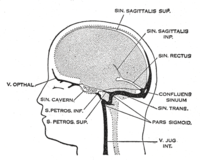
Photo from wikipedia
Background: The novel severe acute respiratory syndrome coronavirus 2 is responsible for over 83 million cases of infection and over 1.8 million deaths since the emergence of the COVID-19 pandemic.… Click to show full abstract
Background: The novel severe acute respiratory syndrome coronavirus 2 is responsible for over 83 million cases of infection and over 1.8 million deaths since the emergence of the COVID-19 pandemic. Because COVID-19 infection is associated with a devastating mortality rate and myriad complications, it is critical that clinicians better understand its pathophysiology to develop effective treatment. Cumulative evidence is suggestive of cerebral aneurysms being intertwined with the hyperinflammatory state and hypercytokinemia observed in severe COVID-19 infections. Case Description: In case example 1, the patient presents with chills, a mild cough, and sore throat. The patient develops high-grade fever of 39.8° C, decreased oxygen saturation of 93% on room air, and an extensive spontaneous subarachnoid hemorrhage (SAH) in the basal cisterns from a ruptured left posterior communicating artery aneurysm. In case example 2, the patient presents with a positive PCR test for COVID-19 2 weeks prior with spontaneous SAH and found to have a large multilobulated bulbous ruptured aneurysm of the anterior communicating artery. Both patients’ symptoms and high-grade fever are consistent with hypercytokinemia and a hyperinflammatory state, with elevated granulocyte colony-stimulating factor, inducible protein-10, monocyte chemoattractant protein-1, M1P1A, and tumor necrosis factor-α inflammatory mediators found to be elevated in COVID-19 intensive care unit admissions. Conclusion: COVID-19 effect on cerebral aneurysms requires future studies to clearly delineate correlation, however, hypercytokinemia and a hyperinflammatory state are strongly implicated to cause degenerative vascular changes that may predispose patients to cerebral aneurysm formation, change in size or morphology, and resultant aneurysm rupture.
Journal Title: Surgical Neurology International
Year Published: 2021
Link to full text (if available)
Share on Social Media: Sign Up to like & get
recommendations!